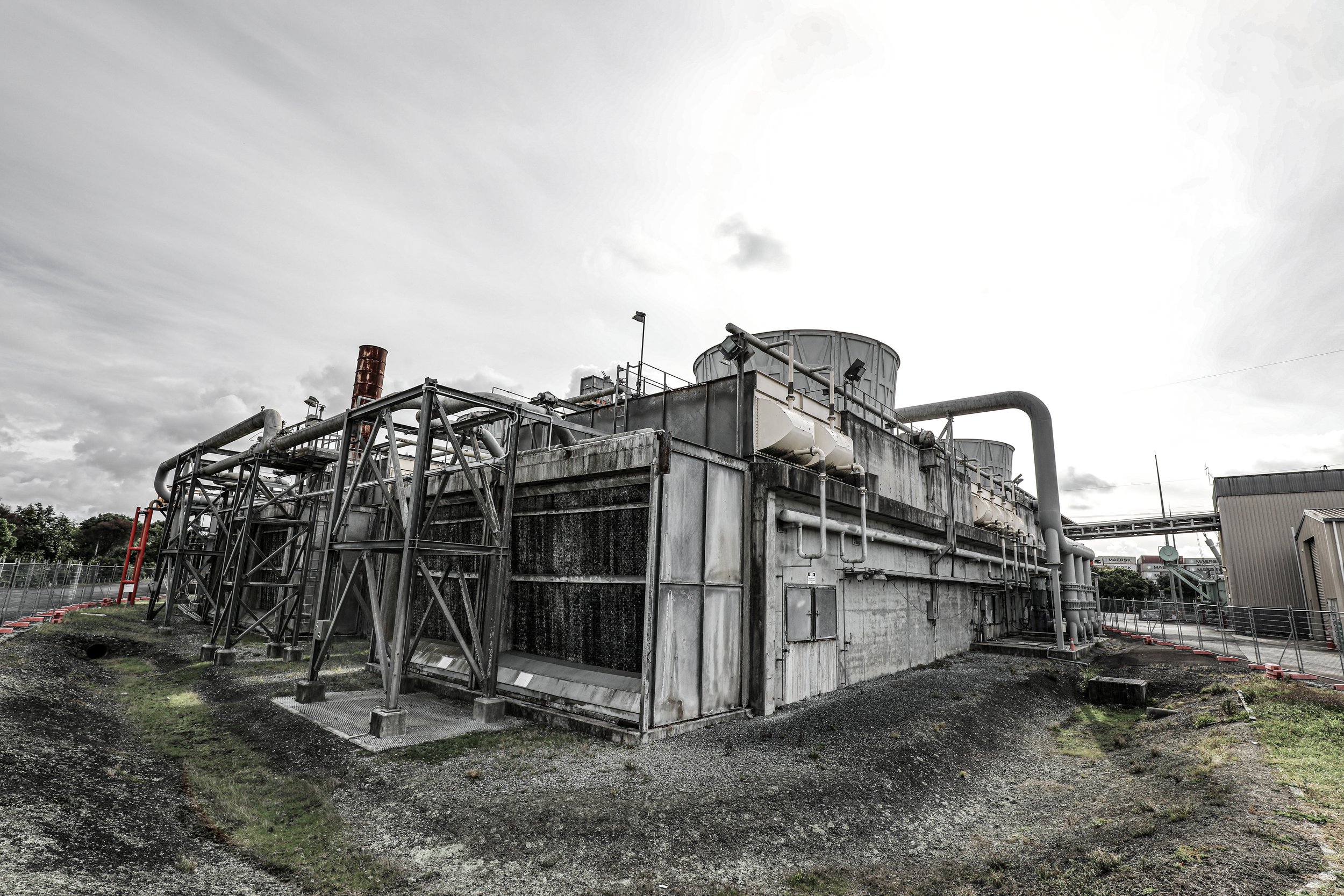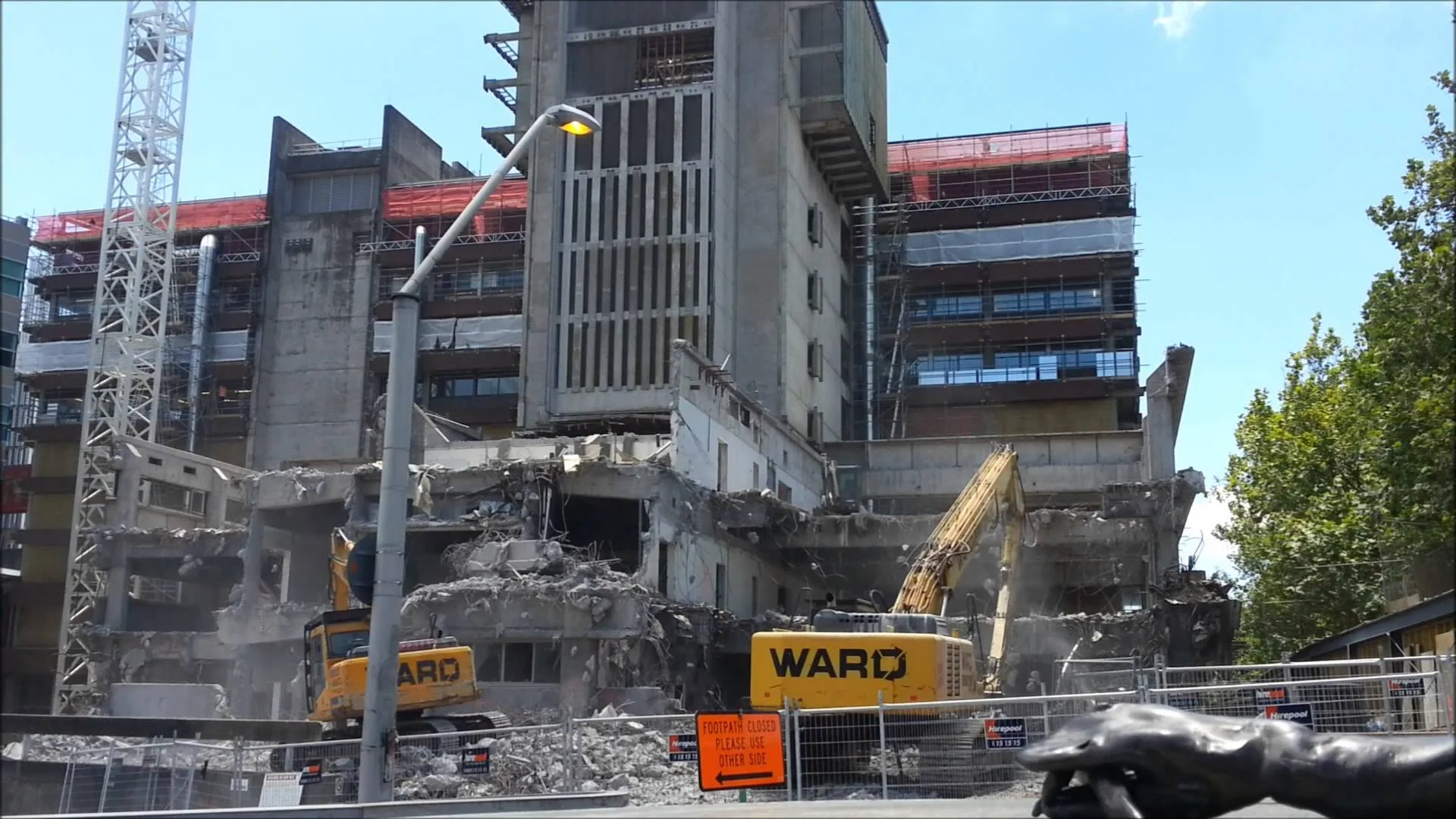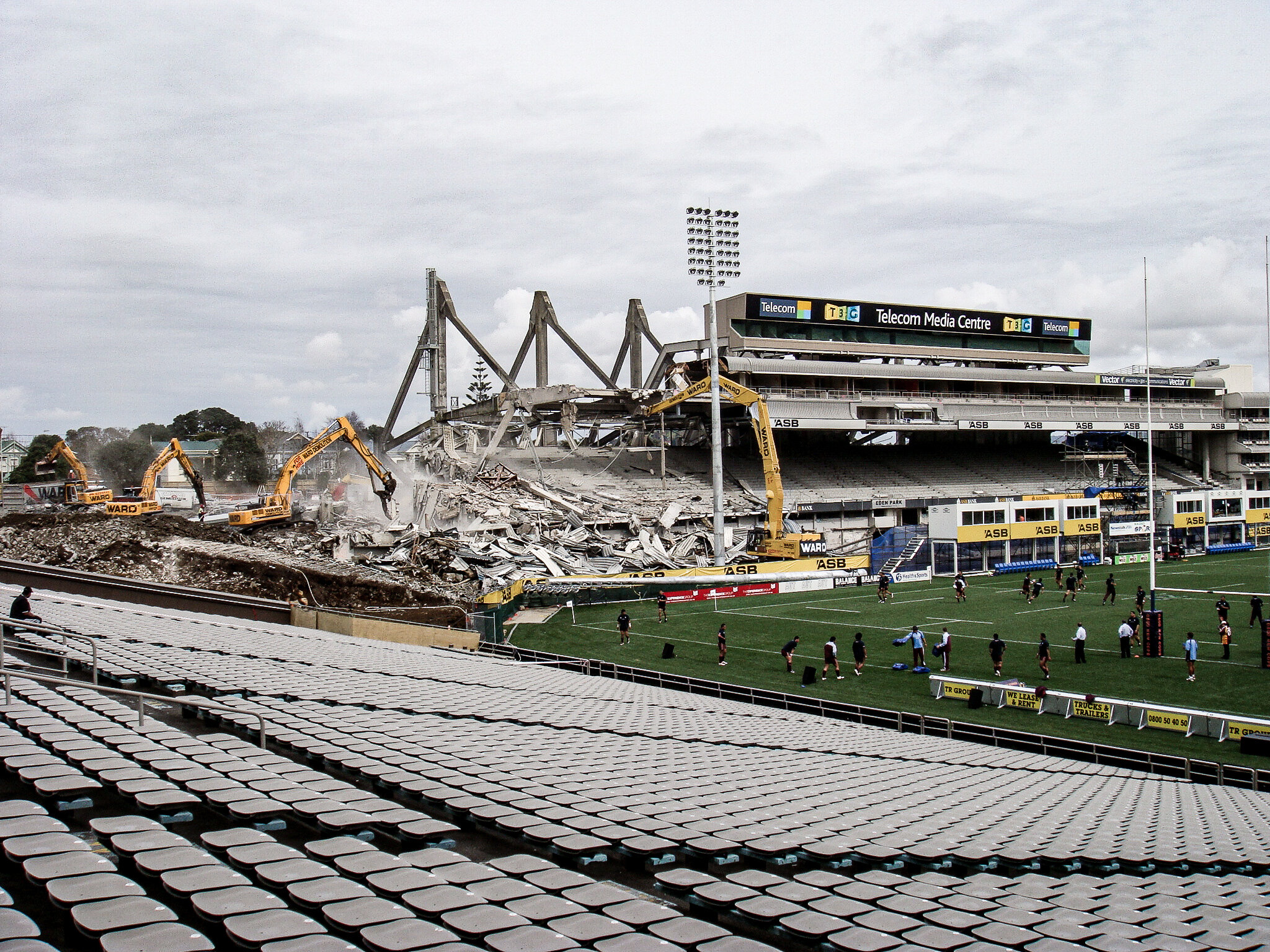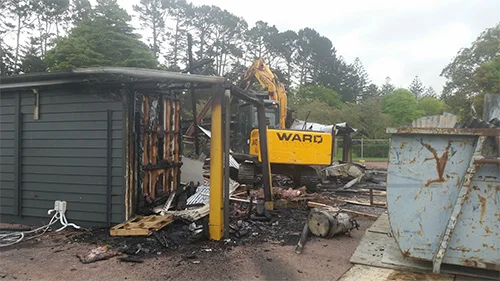Ward Demolition have an extensive portfolio of successful commercial, industrial and residential demolition projects. We profile a selection of these below.
ALEXANDRA PARK STAND
Ward Demolition was handed the task of Demolishing Alexandra Parks’ 100 year old Epsom Balconies Grandstand in Greenlane Auckland. The project featured a tricky separation between the occupied building remaining and the condemned Grandstand, as services vital to the remaining building were located part way across into the building set for demolition. This meant for hand removal of part of the roof section followed by a cut and crane of 9 large truss sections. The first section to be removed sat within millimetres of the glass of the occupied building. Our skilled team successfully completed this task without incident, enabling the remaining large demolition. Read more here.
LONGBURN FREEZING WORKS
Longburn Freezing Works was constructed in 1890 with additions added up until its closure in 1987. The 20,000 square metre site suffered serious decay, partial demolition and salvage theft, over it’s 30 years of abandonment before Ward Demolition was engaged for the clearing of the site. Constructed during the thick of the Asbestos Era the structures were severely contaminated, with over 800 tonnes of friable and non-friable materials present throughout. Another key challenge was the 44-metre-high concrete chimney tower that required demolishing within 5 metres of a live kiwirail train track. Due to the size and complexity of the Job we required a collaborative approach between our Auckland based team and our Wellington division to get the job completed safely. 35,910 hours of labour went into the two yearlong project. Read more on this project here.
MERCURY POWER STATION
The natural gas fired cogeneration power station has proven to be a highly technical job with extremely high risk hazards. Sitting on 2.2 hectares of land set to be completely cleared. Stage 1 involved deconstructing 2 cooling towers, within 3 meters of live 11,000 Volt suspended cables. Operating in close proximity to a live power grid, meant dust and vibration control was crucial to avoid tripping the equipment and cutting off half of the cities power supply. Initial seperation was completed by hand and included cutting pipes with about 80 mm thickness. The weather had to be closely monitored as electrical storms posed extremely high risk for lightening strike. Read more on this project here.
1 QUEEN STREET
1 Queen St is a 20-story building in one of the busiest tourist/ shopping area of the busiest city in New Zealand. Nestled in Auckland’s waterfront precinct, neighboring the ferry building and cruise ship dock. Thousands of people walked past our site every day. Being an extremely high traffic area, access was a challenge and public protection was paramount. Our team was tasked with stripping each floor bottom to top followed by the roof and lift shaft. The building was occupied during the early stages of demolition meaning strict regulations on noise and vibrations. All services had to remain live throughout the building during the strip out phase, many fed through our work zone. Special capture nets and self-climbing screen systems were put in place to protect the high quantity of pedestrians walking past. 320 spandrels and 1700 panes of glass had to be removed from the street facing exterior of the building, alongside feature columns that protruded 1 metre away from the building.
PIGEON PALACE
Ward Demolition’s deconstruction of Albert St’s, pigeon infested, street kid decorated, CBD Auckland, block of buildings was no simple feat. The tallest crumbly high-rise gave us a horrific surprise while pulling in a 7-story high street facing section. We discovered there was absolutely no rebar in the columns. As we stepped down each side of the building, with small machines, in preparation for the high reach, we found no pattern to the columns that had no rebar. Meaning we took extra precautions with every one, by double turfa winching and stropping each section as we pulled them in.
Our New Zealand first, brand New, DXR 300 Robot was a game changer during what amounted to be a high-risk demolition. We were able to break beams out in half the time of the 3 tonne excavators while remaining at a safe distance of 7 story high leading edges. Read more on this project here.
HARRISON ROAD ST JOHNS
Harrison Road contained a large quantity of waste. Despite this a total of 93% of the structure was recovered. Concrete and metal made up 86% of this number. Meaning the original waste pile was 14% of the structure, so how did we bring this down to only 7% of materials heading to landfill? Read more here.
IMPERIAL TOBACCO WELLINGTON
Opened in 1919, the century-old building ceased production of Tobacco by the end of 2020 for Demolition to commence the following year. Situated in the heart of Petone the 44,000 square meter site is set to provide space for another 95 much needed townhouses upon the development's completion. This 7 building Demolition was monumental for Wellington, with the highest level of recycling in history. The overall Recovery Rate was 98%. 100% of the structure's concrete was crushed onsite to be recycled back into the foundations of the new development. A further 5,679 tonnes of concrete was trucked in from other job sites. Meaning 108% of the site’s concrete was recycled with a total of 26,272 tonnes crushed onsite. On top of this, 100% of the steel was recycled (1,893 tonnes) and native timber sacking was salvaged (22 tonnes). The team of 24 men and women worked with some amazing innovations to get the job completed safely. This includes a new dust suppression attachment on the diggers and a Husqvarna DMR140 Robot, used in the lift shaft and unsafe to access locations, allowing staff to remain clear of the hazardous areas while carrying out the tasks. read more on this project here.
WAINUIOMATA SHOPPING CENTRE
The 1970’s, near abandoned shopping centre had become quite the eye sore for locals, it was said to be the saddest shopping centre in New Zealand. With 2 of the 24 spaces occupied the public were very excited to hear of Woolworths $60 million plan to redevelop the area. The ghost mall had to go. The project featured 2 stages of Demolition in close proximity to the surrounding public. Met with tight deadlines the highly experienced team exceeded the clients expectations with time to spare, enabling for a smooth transition into the next phase of the development. Click here to read more and watch the behind the scenes video.
ELLERSLIE RACECOURSE
Gentle isn’t usually a word found in a demolition teams vocabulary, but it became the mantra for the deconstruction of the historic, century old, ‘tote house’, turned old stables at Ellerslie racecourse. The job required a extremely high importance on preserving key pieces of the structure to be restored and featured in the redevelopment. Read more on the history of the building and the ins and outs of the Demolition here.
SENSATION YACHTS
It’s not every day you come across a half built super yacht on the salvage list of a demolition site. In 2017 that’s exactly what happened. Sensation yachts went into receivership halfway through building 3 Super-yachts, These were abandoned onsite, once Ward Demolition received the job they legally belonged to us, with rights to salvage. Two were not worth salvaging and were demolished, the other was sold after a viral nationwide search for a buyer. Read more here.
UNIVERSITY OF AUCKLAND 2014
In 2014 Fletcher Construction contracted Ward Demolition to demolish a 14 level science education building at the University of Auckland, situated in the heart of the CBD, on the intersection of a four lane road and a motorway slipway. There was a roomful of radioactive Cobalt-60 sitting directly under the demolition site, and the building was still connected to a ‘live’ adjoining education building, with a working science lab, conducting experiments sensitive to vibration. Meticulous pre-planning and innovative methodology had to come into play to complete the project safely, on time, and with absolute minimum disruption to the surrounding campus and passing traffic. Nearly 10,000 tonnes of concrete were removed from the site, and Ward achieved a recycling rate of 93%. An intensely technical project, the collaboration between Fletcher and Construction paid off, as Ward took home the 2014 Urban Demolition Award at the World Demolition Awards in Amsterdam.
More information on this project.
HOTEL GRAND CHANCELLOR 2012
A 6.3 earthquake in February 2011 caused irreparable damage to the Hotel Grand Chancellor, an iconic 28 storey hotel and carpark in central Christchurch. The southeast corner had dropped 800mm after a shear wall failed and staircases collapsed, and the building was on a 1.5 metre lean. It was described as one of the worst demolition jobs in the world by international engineers. The potential for loss of life was extremely high, due to the instability of the building, ongoing aftershocks, and probable further serious earthquakes. Ward Demolition faced three major challenges - to stabilise the structure before deconstruction, to maintain safe egress and safety systems, and to apply robust, safe, and quick techniques for deconstruction. Ward undertook significant additional safety precautions, and an attitude prevailed that the most important goal was human survival. “The most important and rewarding part of the work was getting our men home in one piece.” Peter Ward.
More information on this project.
Note: Players are photoshopped on field
EDEN PARK 2008
When Fletcher Construction redeveloped Eden Park for the 2011 Rugby World Cup, they contracted Ward Demolition to take on the demolition of the existing south stand, within a six week timeframe. The stand was a complex structure which had been further complicated by three major alterations, but Ward overcame the technical challenges, and completed the job successfully, within the allotted timeframe. Fletcher’s Project Director Alan Gray credits Peter Ward and his team with eliminating risk to the total project, putting it down to Peter’s extensive experience, 100% personal involvement, and his team’s total commitment to the task. He also sites Ward’s extensive selection of appropriate machinery and plant as key to the success of the demolition. Ward Demolition were proud to provide documentation to substantiate 90.57% recycling of all materials.
More information on this project.
RESIDENTIAL
This building was overcome by fire and needed to be demolished. Ward Demolition was contracted by an insurer to complete this task.
Once on the job, Ward Demolition deduced there was roofing iron still intact, and managed to salvage it. This not only recouped part of the cost of the job but minimised waste.




















